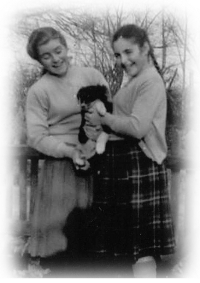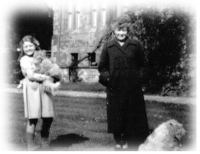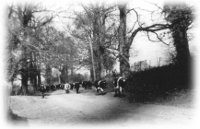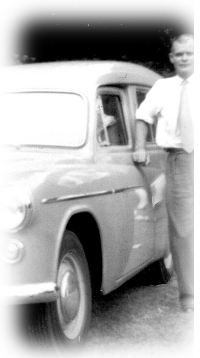
Lesley Chandler, Rosie Lane and Candy the puppy
While Miriam Lane does not appear to have been as intimately involved with villagers as the Buchans had been, she nevertheless played an important part in the welfare of the village. She contributed generously to village events and when one man, the father of five children, was killed on a level crossing at Wheatley, she instructed her lawyer to deal with compensation for the family and bore the expense herself. Her children mixed freely with village children, who had the run of the Manor grounds, and Rosie Lane and the chauffeur’s daughter, Lesley Chandler, were firm friends.

Lesley Chandler and her mother, with Judy the dog and Che Che
There was contact between the maids and the Buckingham family who lived just across the road at Home Close, because Mrs Buckingham was the postmistress and helped them with their letters home, but Mrs Lane did not participate in the WI, as Lady Tweedsmuir had, except to contribute to the funds which provided the Christmas party for the children and occasionally to lend films.
One of the children who attended these parties was Jill Dewhurst, nee Buckingham. She had come to Elsfield as a small child in 1949 with her parents and baby brother Philip, only one month old at the time. They lived at Home Close, which was at that time two houses. Theirs was the one nearest the Manor and as their next door neighbours, the Pinkers, did not have a bathroom, they sometimes went round to the Buckinghams for a bath. There was no water closet; or mains water, although there was mains electricity and water was pumped from the reservoir behind what is now Dove House. When the Pinkers moved out in the 1950s the house was made into one.
As a child Jill attended Christmas parties at the Manor which were held in the basement. She also went to parties at Christ Church in the Great Hall there, as her father worked for Christ Church. There were also outings to the seaside with Christ Church and she had her sixteenth birthday party at Elsfield School which was by that time the Village Hall.

Cows Under Elms
There was a double row of elms along the road which everyone called ‘Under Elms’. The trees had been there for many years and they towered above adults and children alike. Jill found it exciting to ride her bike along under the elm trees because of the wind whistling round her ears. It was so dark it was like entering a tunnel.
The Watts family who farmed the land attached to Forest Farm, Home Farm and Hill Farm, had a television at the time of the coronation, as did the Hambidges. Jill was one of many villagers who watched the event at Forest Farm. There was a big celebration party in the barn at Home Farm including many events such as egg and spoon races and sack races in the field called Home Close after which each child was presented with a Coronation mug.

Mr Chandler, Mrs Lane’s chauffeur
Jill’s mother and father were both from Cowley, but they had met in Kenya when they were stationed there in the Air Force during the Second World War. When they came to Elsfield at first, Jill’s mother was not happy. No-one would talk to her because she was a newcomer, she spoke differently from other people in the village and her husband worked for the landlord, Christ Church. As most families worked on the land there were few points of contact. Tom Buckingham had started work before the war in the Clerk of Works office at Christ Church and on his return, he went to work in the Treasury where he eventually became the Assistant Treasurer. Privately he also did the wages for the farm labourers, for Mr Jack Brown, living at Church Farm, and was a stalwart of the Cricket Club when it reformed in 1953, being both treasurer and secretary.
There were several tradesmen who came to the village because not many people had transport and there were no shops. The baker in Beckley would deliver cottage loaves and groceries could be ordered from a shop in St Clements, delivered weekly by a Mr Tom Pamphlin. The coalman Mr Maunder came out from Islip and Jill and her husband still use the firm today. Cigarettes were available from Mrs Lafford who lived at 1 Hilltop Cottages, and if any of the children went to buy them for their parents she always had a sweet to give them. Her son Denis eventually became the village postman.
The Beckley bus (number 72) provided a link for shopping in Oxford. The timetable had been devised to facilitate hospital visiting at the local hospital, the Radcliffe Infirmary on the Woodstock Road. It ran on a Wednesday, Friday and Saturday from Oxford at 2pm, 4pm, 6 pm and finally at 10 pm on a Saturday only. There was an afternoon service on a Sunday. In the early fifties by the time the bus reached Elsfield it was often almost full and provided the opportunity for a good gossip and catch-up between villagers. In later years with more people having cars the number of passengers dwindled until the service was eventually withdrawn, probably in the late 1960s.
Mrs Marion Colwell was the lady who delivered the post, not just in Elsfield but in Beckley as well and when she retired her daughter Helen took over. The unsorted post would be brought out from Oxford and she would sort it at Home Close and then cycle through the worst of the weather, including heavy snow (twice a day coming up to Christmas), to make sure the post reached its destination. Mrs Buckingham would help the Gypsies deal with officialdom if they needed help with any paperwork. At first the Post Office was one of the few places in the village with a telephone. The Manor was number seven, while the telephone kiosk outside the school, the only public telephone in the village, was number five. Calls went through to the exchange in Stanton St John, where they were answered by one of the Knight family who ran the Post Office. Brenda Knight, who was competently manning the exchange at the age of eight, recalls that the telephone exchange was in their living room. There was a race not to be last at the dinner table because the last one to the table had to answer the telephone when it rang. It was a twenty-four hour job. There were nineteen or twenty people in the area who had telephones and people often didn’t ask for a number, just said who they wanted to contact. Quite often her aunt would say, ‘Well, it’s no good ringing them now, they’ve gone up the village’, in which case the person ringing would ask to leave a message.
Post Box Cottage was occupied in the 1960s by the Brown family who rented it from David Brown, the farmer, at £2 a week, a sum which was collected once a year. Mark and Darren lived there with their parents, next door to the Sandfords. Mr Sandford was the gamekeeper and Mrs Sandford the pest control person. Mrs Brown was convinced she saw the ghost of an undertaker walking up their path, an idea which her boys scoffed at until they discovered that Caleph Clark and bled to death in their house.
Mark was taught by Sue Bradford how to eat soup correctly – with the spoon tipped away from his mouth – and how to eat peas by conveying them from plate to mouth on the top of his fork rather than using it as a scoop. Though he now lives in Berinsfield, Mark has warm memories of Elsfield, which he has always loved and sometimes visits. There are three photographs of Mark and his family in the Gallery.
At this time there were milking herds at Forest Farm, Church Farm and Home Farm. Jill would collect milk in a jug from Home Farm and eggs were bought from Mrs Brown at Church Farm. You took along a cereal packet and she then wrapped the eggs in newspaper and placed them inside. The cows also had to be kept out of the cricket square in Home Close so the team could practice and the pitch remained playable.
Jill started at the village school when she was about four and a half. When she was eight the school closed and then together with a friend, Lois Watts from Hill Farm, she attended a school on the Banbury Road until she was 11 years old when she moved to Old Marston secondary school. The Elsfield school building was then rented from Christ Church and run as a village hall and was still there in 1968. Previously the older children in the village had attended Gosford Hill School in Kidlington.There was no transport from Elsfield to Marston School so they all had to cycle. At the bottom of the hill was a three-lane road which was replaced by the ring road. It was very dangerous because there was a dog-leg where people going towards Oxford had to do a right and then a left turn, crossing the main road. Traffic was very fast along the main road and there were several fatalities. One was a girl who lived in the cottage by Field Barn: Julie Hadland. It was her first week at grammar school. The Reverend Jarvis was also involved in a serious crash there. Mrs Bedding used to accompany her daughter Joan and other village children to make sure they crossed the road safely, but Mrs Buckingham could not do that because she ran the Post Office. Many mornings on their way to school the children passed gypsies camped in a lane to the side of the road which ran into Mill Lane in Marston and horses were regularly to be seen tethered along the verges.
In 1955 the school was closed, with Elsfield children of Primary school age moving to Beckley school. This posed a problem for the village, since the building had been used not only as a school but as a meeting place for social events. Not only the Social Club but the Men’s Club and the Women’s Institute had all used the premises at one time or another.
In November of 1955 a well attended meeting, chaired by the Vicar, met to discuss the future. The Vicar had already approached Christ Church, owners of the property, who had agreed that the school room could be used as a village hall. The Vicar pointed out how fortunate the village was in having a building in first rate repair and said how grateful everyone should be to Christ Church for their generosity. £100 had already been collected towards building a village hall, and discussion centred around whether the money should be used for maintenance of the school room. Mr Brown proposed that the money should be put to that purpose. Mr Taylor of Home Farm seconded the motion and the money was passed to the treasurer . A committee was then set up to run the village hall. The chairman was the Reverend Jarvis, secretary Mrs T. Buckingham, treasurer Mr Hambidge. Other members of the committee were drawn from the Lafford and Merry families along with Mr F. Hayes and Mrs J. Maltby. Christ Church, owners of the building, agreed to a rent of one shilling a year, with the insurance of £3-3-9d. Surplus funds raised for the Coronation celebrations were given into the hands of the treasurer and it was agreed that Mrs Paintin should be paid £1 a month to look after the hall. Charges for hire of the hall would be ten shillings and five shillings for hire of half the big room. The chairman was instructed to order ½ ton of coal from Mr Tembs of Wheatley.
The Village Hall committee carried on for several years, organising events and maintaining the buildings in good order. In 1959 the roof was re-thatched and there was discussion about the wisdom of changing from coal fired heating to oil stoves. Mr Shirley of Noke was asked to examine the roof where it leaked, put the lavatories in good repair, fix an outside light and mend sundry broken windows. His estimate of £10 was accepted and he was asked to do the work. The room was now costing £22 a year to run but the WI was concerned that the Village Hall committee was using their crockery. Mr Brown suggested that when the time came to replace the crockery, both organisations should pay half.
By 1963 the lack of regular bookings was making it difficult to run the building without drawing on reserves and their capital was decreasing. They agreed to have a yearly collection to supplement the takings from hire of the hall. They also increased the hiring charges to £1-5s for the whole hall and 12/6d for half. Weddings, where more electricity would be used, would incur an extra charge of two guineas. The idea of voluntary contributions was successful and raised £22, which included a donation of £10 from Mrs Lane, who had now succeeded Lady Tweedsmuir at the Manor.
The Village Hall continued organising events and looking after the school building until November 1967, when Mrs Buckingham reported that Christ Church was prepared to take the building back without claiming for dilapidation. Mr Hoyle proposed the tenancy be relinquished and this was seconded by Mrs Garson of Hill Farm. The building was subsequently pulled down.
The Cricket Club
Cricket was played in the field called Home Close.The cows had to be shooed off first and a hit to the boundary was deemed to be beyond the chestnut tree. The cricket team had been disbanded at the start of the war in 1939 but reconstituted in 1953. Mr Hays of Hill Farm, son-in-law of Mr W.F/G Watts who had sold a ram in thanks for the successful outcome of the Battle of Britain, was a member of the committee and farmed Home Close. He promised to wire off a suitable square to keep cattle out and 200 rolls of turf were bought for which the club paid £5. There was an old caravan which acted as a pavilion.
The annual subscription was ten shillings. Mr GJ Brown promised to give a cricket bat, as did Mr Howe. Miss Stace, the teacher, gave three cricket balls, Mr Hayes gave gloves while Mr E. Taylor gave stumps and bails. There were eighteen members.
The club seems to have started off with a great deal of support, but by 1955 it was noted that there was little likelihood of the boys in the village wanting to play so outsiders should be considered and members were asked to refer anyone they knew who might be interested to the secretary. Wednesday evenings was practice night and a get-together at the Cherwell pub was suggested before the season began.
The Home Close ground does not seem to have been good enough to play all the home matches on, and in 1955 these were played either on Sunnymeade recreation ground ,near Cutteslowe, or on Banbury Road North Sports ground. Fixtures were played throughout the summer against teams drawn from other villages such as Islip , Bladon, Sandford and suburbs of Oxford such as New Marston and Cowley. For away matches a coach was hired which transported not just the players, but supporters, wives, girl friends and children. Jill Dewhurst, nee Buckingham, remembers these outings as being very enjoyable events. If the team were playing at home Mrs Buckingham along with Mrs Everett and other wives made the teas in the Manor barn.
The Women’s Institute
In March 1953 Britain was obviously perceived as suffering from food shortages, as the branch received a food parcel from Belmont WI in Ontario, Canada. To thank them a book about the Coronation was sent, which cost 17/6d plus postage. The Coronation was also celebrated by a Coronation Tea Party at Queen’s College in May when three members of the branch were invited to participate at a cost of 3/6d a head. Mrs Lafford made a surprise Coronation cake in June and another for the Christmas party in December. They were very much appreciated, the secretary noting that ‘Our party would not have been complete without Mrs Lafford’s delicious cake’.
On a more serious note the Oxfordshire Federation asked the branch to support a resolution calling for steel cap helmets to be worn by cyclists, a message which has not been taken seriously by many present day cyclists.
Lady Tweedsmuir moved out of the village in 1953 so was unable to carry on being president but was regularly invited to meetings and in 1954 Mrs Taylor of Home Farm was again elected President in Lady Tweedsmuir’s place .Mrs Taylor was the wife of a Christ Church don, Frank Taylor, a New Zealander by birth. Mrs Taylor’s maiden name was Gurdon, a family who gave their name to one of the fields in Elsfield and whose ancestors had lived in Elsfield throughout the 19th century.
By 1954 whist drives were going out of fashion. In November Mrs Phipps said it was no good organising a whist drive because nobody would come but the new fashion for square dancing was popular and the dance arranged the previous month had realised £8-7-6d. A dance arranged in 1955 along with two special films lent by Mrs Lane resulted in about 50 people attending, including 14 members.
Occasionally the branch continued to bring in speakers from as far away as India, Ceylon and South Africa, they raised money for various good causes and of course they organised competitions: chocolate cake making, and best arranged wild flowers among them. The June meeting was usually held at Gunfield, the home of the Denekes and in 1956 Elsfield women met up with old friends Mrs Aste, widow of the Reverend Aste, and Mrs Hambidge, who must by this time have been living with one of her daughters, her husband having died. The secretary notes that following a talk by Lady Tweedsmuir about a family visit to America, ‘Then followed our grand tea, beautifully laid out by our kind hostesses. This is one meeting in the year we all look so forward to and thoroughly enjoy every minute. Transport is also provided for us, we owe many thanks’.
Mrs Taylor continued to be president for several years but in 18th March 1964 following her move from Elsfield, no-one else felt able to stand for president and the branch closed.
